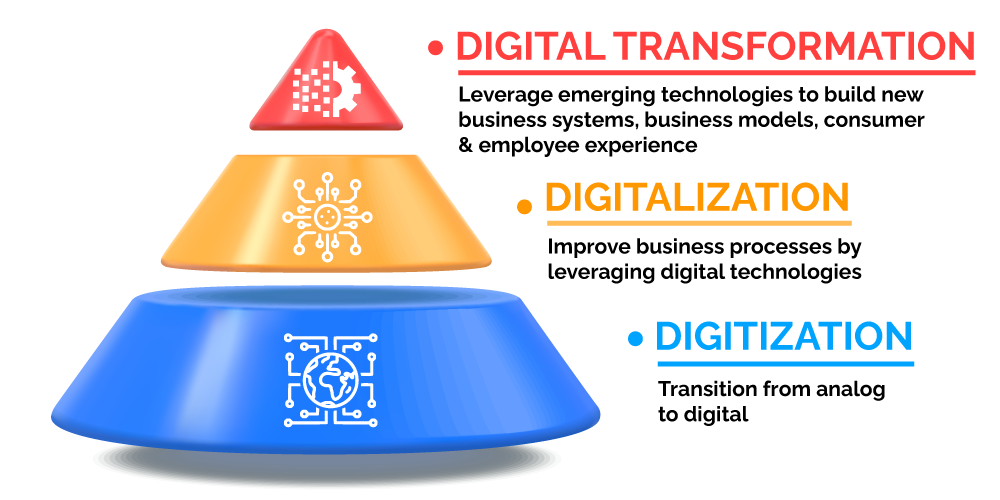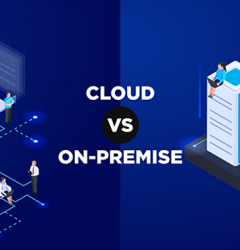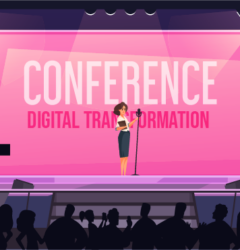
Digitization, digitalization, and digital transformation are all terms that have been very prominent since the late 2000s. They have been used interchangeably, often for the wrong reasons, and potentially not given the importance they deserve.
Have you ever gotten in a conversation where someone is talking about putting their business through the process of digitization? Have you ever considered the three processes’ differences and what they truly mean for a business? While most people are not that clueless, there is a missing link in terms of the direction these terms provide, and we want to sort those out today.
None of these terms exist without one another. All three are somewhat the same since their inception; there have been advances and adjustments in how they are defined over the years.
Let’s explore !!
What is Digitization?
Digitization is a conceptual term that holds many associations across a variety of literature. It is the term for creating a digital version of analog things. It converts physical matter into digital format. For example, paper documents, microfilm images, photographs, and more into bits and bytes that define them.
All in all, it is the simple process of re-representing non-digital data in a digital format that can then be used by the computing system in a variety of ways and for different functions. Thus, in this whole process, nothing of the original document is lost. While in many cases, the original item is destroyed to clear up space, in any case, it lives on in digital forms.
Examples:
- Scanning bills, documents, and files
- Transferring meeting minutes and notes from paper into an Excel sheet

What is Digitalization?
Digitalization, in most cases in business, refers to improving business processes, business functions, business operations, and more by leveraging the new technology the digital space provides. It allows new systems to be set up in the context of digitalization to make business easier and achieve any/ all benefits the business may have in mind.
Also Read: Most Mind-Blowing Examples of Digital Transformation
Digitalized businesses can lead to digital businesses and increased scope for business growth. On average, digitalization in this sense of the word is seen as the middle step towards digital transformation and the creation of digital revenue streams.
Digitalization is seen as the middle step between Digitization and Digital Transformation towards the creation of digital revenue streams.
Examples:
- Moving PDFs and Word documents into a shared cloud
- Making personal resources with relevant data available to the business
- Creating online, downloadable video databases
Also read: Digital Modernization a Must. Modernize your Enterprise IT today!
What is Digital Transformation?
Digital transformation is the business-wide process of going digital; it is ahead of the silo-based structure created by digitalization and allows for massive growth potential. It is focused on faster, more efficient, and more pointed digital growth.
Digital transformation marks a radical rethinking of how an organization uses technology, people, and processes to fundamentally change business performance.
George Westerman, MIT principal research scientist and author of Leading Digital: Turning Technology Into Business Transformation
Digitalization and digital transformation are often confused and used interchangeably. However, it is not completely right to do so. Digital transformation in the context of today has a much broader scope than digitalization. It requires many more hurdles to be crossed by a business to create and implement a strategy as compared to digitalization.
Examples:
- A system analyzing the data from an Excel sheet on your cloud and classifying the data by its importance and relevance
- Online video streaming
- Suggesting business changes through computer-analyzed data
Also Read: What are the Components of Digital Transformation?

Comparison between Digitization, Digitalization, and Digital Transformation
Digitization makes Data Digital, Digitalization Leads to Digital Business, and Digital Transformation requires Digitization and Digitalization
| Digitization | Digitalization | Digital Transformation | |
|---|---|---|---|
| Focus | Data Conversion | Information processing | Knowledge leveraging |
| Goal | Change analog to digital format | Automate existing business operations and processes | Change the company’s culture, the way it works and thinks |
| Activity | Convert paper documents, photos, microfilms, LPs, films, and VHS tapes to digital format | Creation of completely digital work processes | Creation of a new digital company or transformation to a digital one |
| Tools | Computers and conversion/encoding equipment | IT systems and computer applications | Matrix of new (currently disruptive) digital technologies |
| Challenge | Volume Material | Price Financial | Resistance to change Human Resource |
| Example | Scanning paper-based registration forms | Completely electronic registration process | Everything electronic, from registration to content delivery |
Also read: Digital Transformation Demystified !!
Examples of Digitization, Digitalization, and Digital transformation Across Different Industries
Here are specific examples of digitization, digitalization, and digital transformation across different industries
Healthcare
- Digitization: Converting patient X-rays, medical records, and other documents into digital formats for easier access and storage.
- Digitalization: Implementing electronic health records (EHRs) to manage patient data, track appointments, and automate prescription requests.
- Digital Transformation: Utilizing telemedicine platforms for virtual consultations and remote patient monitoring using wearable devices and sensors.
Education
- Digitization: Scanning textbooks and other learning materials into digital formats for online access or e-readers.
- Digitalization: Using online learning platforms with interactive content and personalized learning pathways.
- Digital Transformation: Creating blended learning models that combine in-person classes with online learning activities and virtual reality (VR) simulations for immersive learning experiences.
Retail
- Digitization: Implementing barcode scanners at checkout counters to track inventory and manage pricing.
- Digitalization: Launching online stores and offering mobile apps for browsing, purchasing, and tracking orders.
- Digital Transformation: Using AI-powered chatbots for personalized customer service, analyzing customer data to offer targeted recommendations, and integrating augmented reality (AR) apps to allow virtual product try-on experiences.
Also Read : Mastering Multiple Series Reports: Visualizing Complex Data in 4 Steps
Manufacturing
- Digitization: Converting machine manuals and production data into digital files for easier access and analysis.
- Digitalization: Implementing computer-aided design (CAD) and computer-aided manufacturing (CAM) software for product design and automated production processes.
- Digital Transformation: Utilizing 3D printing for rapid prototyping and small-batch production, integrating AI-powered predictive maintenance to prevent equipment failures, and leveraging digital twins – virtual models of physical assets – to optimize production processes and energy consumption.
Finance
- Digitization: Scanning paper checks and financial documents for electronic storage and processing.
- Digitalization: Implementing online banking platforms and mobile apps for account management, bill payments, and investment transactions.
- Digital Transformation: Utilizing blockchain technology for secure and transparent financial transactions, offering robo-advisors for automated investment management, and using AI-powered fraud detection systems.
Media & Entertainment
- Digitization: Converting physical media like film and music tapes into digital formats for archiving and online distribution.
- Digitalization: Implementing streaming platforms for online access to music, movies, and TV shows.
- Digital Transformation: Using AI-powered recommendation algorithms to personalize content suggestions, creating interactive storytelling experiences through virtual reality (VR) technologies, and utilizing social media for community engagement and content creation.
Transportation
- Digitization: Implementing electronic ticketing systems for public transportation and toll roads.
- Digitalization: Offering ride-hailing apps for booking taxis and ridesharing services.
- Digital Transformation: Developing autonomous vehicles (AVs) for self-driving transportation, utilizing real-time traffic data management systems to optimize traffic flow, and exploring electric and hydrogen vehicle technologies for sustainable transportation solutions.
Logistics & Supply Chain
- Digitization: Scanning barcodes and product labels to track inventory and shipment details.
- Digitalization: Implementing warehouse management systems (WMS) and transportation management systems (TMS) for automated inventory control and efficient logistics planning.
- Digital Transformation: Utilizing blockchain technology for transparent supply chain management and tracking of goods, implementing robotic process automation (RPA) in warehouse operations, and leveraging data analytics for demand forecasting and optimizing delivery routes.
Government
- Digitization: Converting official documents, records, and citizen data into digital formats for secure storage and access.
- Digitalization: Offering online government services such as e-filing for taxes, permit applications, and online voter registration.
- Digital Transformation: Utilizing e-governance platforms for citizen engagement and participation, leveraging AI-powered chatbots for citizen service delivery, and implementing data-driven policymaking based on real-time analytics.
These examples demonstrate how digitization, digitalization, and digital transformation can be applied across different industries to improve efficiency, enhance customer experience, and create innovative and sustainable business models.
How Digitization, Digitalization, and Digital Transformation Are All Leading the World
In today’s tech-driven economy, it’s not about choosing one over the other—it’s about understanding how each stage plays a critical role in reshaping industries, governments, and human experiences. Here’s how all three are powering the future together:
1. Digitization: Powering the Data Foundation
Digitization—converting analog information into digital formats—is the first spark of the digital era. It enables organizations to store, retrieve, and process data at scale.
Real-World Impact:
- Governments digitizing land records, birth certificates, and IDs
- Healthcare systems scanning patient histories and prescriptions
- Financial institutions digitizing decades of customer data for AI-driven insights
📈 Why It Matters:
Without digitized data, AI, analytics, and automation can’t function. It’s the foundation of every modern innovation.
2. Digitalization: Fueling Operational Excellence
Digitalization builds on digitization by integrating digital tools into daily operations—enhancing efficiency, speed, and accuracy without overhauling the core business model.
Real-World Impact:
- Banks automating loan approvals using digital workflows
- Manufacturers using IoT sensors to optimize machine uptime
- Schools using LMS platforms to conduct virtual classes
Why It Matters:
Digitalization helps businesses do more with less, eliminate manual errors, and deliver consistent experiences across channels.
3. Digital Transformation: Redefining Business and Customer Experience
This is the strategic reinvention of how organizations operate and deliver value—powered by cloud, AI, automation, data, and user-centric thinking.
Real-World Impact:
- Netflix reimagining entertainment through personalized streaming
- Tesla turning cars into connected smart devices
- Retailers like Zara using real-time data to drive production decisions
Why It Matters:
Digital transformation is what drives disruption, innovation, and long-term growth. It aligns people, processes, and technology around a bold new vision.
Together, They’re Powering a Digital World
Each of these layers—digitization (data), digitalization (efficiency), and digital transformation (strategy)—contribute uniquely to a more connected, intelligent, and agile world.
To lead in 2025 and beyond, organizations must embrace all three—not just as trends, but as building blocks of future-ready success.
Here are some stats supporting the initiatives:
1. A Trillion-Dollar Digital Economy
The digital economy is expected to reach $16.5 trillion by 2028, representing 17% of global GDP, with a 6.9% CAGR from 2023–2028
2. Massive Investment in Digital Transformation
Worldwide digital transformation (DX) spending reached $2.5 trillion in 2024 and is projected to grow to nearly $3.9 trillion by 2027, at ~16.2% annual growth.
3. Enterprise-Level Adoption
94% of large organizations have a formal digital transformation strategy, while 89% of C‑suite executives have led at least one major digital initiative in the past two years .
4. Operational Efficiency Gains
Digitally mature companies report 40% greater operational efficiency, 36% faster time-to-market, and a 35% increase in customer satisfaction.
5. Driving Financial Inclusion
Digital finance initiatives could bring 1.6 billion unbanked people into the formal economy by 2025, potentially creating 95 million new jobs and boosting developing economies by $3.7 trillion (Time).
6. Digital Divide Still Large
Despite tremendous progress, around 2.6 billion people—over one-third of the global population—remain offline .
7. Foundation for AI and Future Tech
Digital transformation sets the stage for AI. As of 2024, 78% of organizations were experimenting with or using AI in operations; investment trends show AI integration accelerating due to strong digital backbones.
These initiatives are not only fueling economic growth, but also transforming business efficiency, accelerating enterprise adoption, driving financial inclusion, and enabling next-gen AI technologies—even as challenges like the digital divide remain.
Also Read: How Quixy ensured sunshine at Sunworks with 20% improvement in sales conversion
The Benefits of Digitalization: Why It Matters Now More Than Ever
Digitalization isn’t just a buzzword—it’s a game-changer. As businesses evolve to meet the demands of a fast-paced, tech-driven world, digitalization is helping them stay ahead, work smarter, and deliver better experiences. Here’s how:
1. Improved Efficiency
Manual processes slow things down. Digitalization automates repetitive tasks, reduces paperwork, and streamlines workflows—freeing up time for teams to focus on meaningful work. Whether it’s processing invoices or managing employee onboarding, things get done faster and with fewer errors.
2. Cost Savings
When operations are more efficient, costs naturally come down. Digital systems reduce the need for physical storage, cut down on human errors, and minimize reliance on outdated infrastructure. Over time, these savings can be substantial—especially for large organizations.
3. Real-Time Data Access
One of the biggest advantages of going digital is instant access to accurate, up-to-date information. From customer insights to inventory levels, data-driven decision-making becomes much easier when everything is centralized and accessible in just a few clicks.
4. Better Customer Experience
Customers today expect quick, personalized, and seamless experiences. Digitalization makes that possible through chatbots, automated emails, self-service portals, and personalized content—helping businesses meet customer needs without delay.
5. Scalability and Flexibility
Need to add a new service, onboard a new team, or shift to remote operations? Digital systems scale easily, adapt quickly, and support business growth without major disruptions. This agility is key in today’s unpredictable markets.
6. Stronger Collaboration
Digital tools enable real-time collaboration, even across geographies. Teams can co-create, share updates, and track progress using platforms that keep everyone connected and aligned—whether they’re in the office or halfway around the world.
7. Enhanced Security and Compliance
With the right digital tools in place, businesses can better protect their data and ensure compliance with industry regulations. Role-based access, audit trails, and automated backups reduce risk and keep sensitive information secure.
8. Sustainability
Going digital also supports eco-friendly practices. By reducing paper usage, cutting travel needs, and improving energy efficiency, digital operations contribute to a more sustainable future—a win-win for businesses and the planet.
📂 Benefits of Digitization
Laying the digital foundation.
- Easy Data Storage & Access
Converting physical documents into digital formats makes information easier to store, search, and retrieve. - Reduced Manual Errors
No more data loss due to faded printouts or misplaced files—digital formats are more accurate and reliable. - Faster Information Sharing
Digital files can be shared instantly across departments or locations, improving internal collaboration. - Cost Savings on Physical Infrastructure
Cuts down on paper, storage cabinets, courier costs, and manual admin tasks. - Better Compliance & Archiving
Easier to maintain audit trails, backup records, and comply with legal/regulatory requirements.
⚙️ Benefits of Digitalization
Streamlining and optimizing processes.
- Process Automation
Replaces repetitive tasks with smart workflows, saving time and improving productivity. - Improved Operational Efficiency
Reduces bottlenecks, shortens cycle times, and ensures faster decision-making. - Real-Time Insights
Access to dashboards and analytics tools allows managers to monitor performance and act quickly. - Enhanced Customer Interaction
Digital touchpoints (like chatbots, apps, and e-portals) enable quicker, more personalized service. - Lower Operational Costs
Cuts down human errors, manual rework, and time-consuming approval chains.
🚀 Benefits of Digital Transformation
Reimagining value delivery and competitive advantage.
- Business Model Innovation
Enables the creation of new digital products, services, or revenue streams (think: Netflix, Uber). - Customer-Centric Experiences
Uses AI, data, and automation to deliver tailored, seamless, omnichannel customer journeys. - Faster Time-to-Market
Empowers agile development and experimentation, so new ideas move from concept to reality quickly. - Data-Driven Culture
Empowers all levels of the organization to make smarter, insight-backed decisions. - Organizational Agility & Resilience
Helps companies respond faster to market disruptions, technology shifts, and customer expectations.
Why You Need All Three
Together, these stages create a comprehensive roadmap for innovation:
- Digitization → Ensures you have clean, accessible data
- Digitalization → Makes that data work for you
- Digital Transformation → Unlocks new possibilities from that momentum
In short: you start with structure, scale with smart systems, and lead with innovation.
Real World Examples
DMart (Avenue Supermarts, India) – Inventory & Procurement Automation
DMart uses homegrown software to manage procurement, warehousing, billing, and restocking. They minimized reliance on third-party tech and increased margin control.
✅ Impact: Efficient cost structures and rapid expansion across India.
Mahindra & Mahindra – Digital Dealerships & After-Sales
The Indian auto major implemented digital CRM, remote diagnostics, and paperless dealerships. Their “With You Hamesha” platform supports service scheduling, live updates, and roadside assistance.
✅ Impact: Faster customer service and enhanced loyalty in competitive markets.
Capgemini – Internal Automation with AI Bots
Capgemini introduced AI-driven chatbots, automated workflows, and self-service IT desks internally. They also launched AI4Ops, automating IT operations for clients.
✅ Impact: Reduced ticket resolution time and enhanced employee experience.
Healthcare – Apollo Hospitals’ Digital Health Initiatives
Apollo uses a digital health record system, AI-powered diagnostics, and teleconsultation services. Their AskApollo platform enables patients to book appointments, access reports, and consult doctors online.
✅ Result: Streamlined patient journeys and increased access to healthcare
Siemens’ Digital Twin Technology
Siemens uses digital twins—virtual replicas of physical assets—to monitor equipment in real time, simulate maintenance, and reduce downtime in factories.
✅ Result: Faster production cycles, predictive maintenance, and reduced costs.
DBS Bank’s Digital Transformation (Singapore)
DBS rebranded itself as a “digital-first bank,” offering paperless account opening, AI-based customer support, and fully digitized lending. It built over 200 digital APIs to embed banking into other services.
✅ Result: Named “World’s Best Digital Bank” multiple times with increased customer satisfaction and agility.
Government – Estonia’s e-Government Model
Estonia is a world leader in digital governance, offering over 99% of public services online, including tax filing, voting, healthcare access, and digital ID verification.
✅ Result: Massive cost savings, reduced red tape, and high citizen satisfaction.
Big Brands Went Digital—Because It’s the Need of the Hour
From Amazon’s robotic warehouses to DBS Bank’s AI-powered services, leading brands across the globe are embracing digitalization not just for efficiency—but for survival and growth. It’s no longer a “nice to have”—it’s a business imperative.
Why? Because digital-first organizations innovate faster, respond to customer needs in real time, and stay resilient in uncertain markets. Whether it’s Maersk using blockchain to reinvent logistics or Roche applying AI in diagnostics, digitalization is driving powerful transformation across industries.
But even these giants aren’t immune to challenges.
Traditional Digital Development Comes with Friction
Behind the scenes, most companies—even the most well-funded—face roadblocks when deploying digital initiatives through traditional development approaches:
- Long development cycles
- Expensive IT resource allocation
- Complex integrations
- Resistance to change from non-technical teams
- Scalability and maintenance headaches
For many mid-sized businesses or even departments within large enterprises, these bottlenecks can stall innovation. The result? Great ideas get buried in backlogs.
Enter Low-Code No-Code: The Smart Path to Digital Success & Effortless Management
This is where Low-Code/No-Code (LCNC) development changes the game.
Rather than relying solely on overburdened IT teams or expensive software rollouts, LCNC platforms empower business users, domain experts, and innovators to build apps, workflows, and automations—without writing complex code.
And it’s not just about speed or simplicity—it’s also about redefining how businesses manage digital operations at scale.
The result?
- Faster deployment
- Lower costs
- Agile experimentation
- Real-time iteration
- Seamless collaboration between business and IT
- Effortless management of apps, data, and user roles
- Scalable governance without complexity
LCNC doesn’t just bridge the gap between vision and execution—it eliminates the chaos that often follows traditional development by offering built-in role-based access, centralized control, and real-time monitoring.
In short, it makes digital transformation accessible, manageable, and sustainable—for teams of all sizes.
Whichever Stage You’re In, Quixy’s Got You Covered
Adapting a no-code low-code digital platform like Quixy can be a transformative step. It is not only about paperless transformation but also about reshaping the flow of data, operations, etc.
Quixy empowers teams across departments to build customized applications rapidly without requiring any coding expertise, making the development of complex workflows & integrations accessible to everyone. It also fosters rapid application development,enabling businesses to adapt to shifting market demands and innovate at speed.
Here are the reasons why to integrate Quixy with a no-code platform for a seamless digitization process –
- Smarter Development with AI Caddie
- Comprehensive Project View
- Precision-Controlled Business Rules
- Enhanced Data Organization
- Customizable Applications at Speed
Whether you’re just starting to digitize your operations, optimizing them with automation, or reinventing your business model altogether—Quixy is built to support your journey.
📂 Starting with Digitization?
Quixy helps you turn paperwork and manual tasks into structured digital data. With features like smart forms, document uploads, and OCR (optical character recognition), your team can eliminate paper trails and centralize information—fast and accurately.
⚙️ Ready for Digitalization?
Move beyond data storage. Use Quixy’s drag-and-drop workflow builder, role-based access, and process automation tools to streamline approvals, manage tasks, and drive operational efficiency—all without writing code.🚀 Driving Digital Transformation?
Quixy empowers you to reimagine how your business runs. Build end-to-end applications, launch customer portals, integrate with your existing systems, and make data-driven decisions with dashboards and real-time reporting—all from one powerful platform.
Quixy isn’t just a tool—it’s your digital enablement partner, helping you modernize at your pace, with your people, on your terms.
So no matter where you stand—digitizing documents, automating workflows, or leading digital change—Quixy makes it possible, manageable, and scalable.
Conclusion
If you want to add any of these processes to your business, consider thinking of an experienced no-code solution like Quixy. Quixy offers a straightforward, no-code low-code approach to digitalization and will help your business complete a successful digital transformation. Today, organizations across verticals are using Quixy to transform how they operate digitally.
Don’t miss out on the chance to elevate your processes. Take the first step by scheduling a demo call to get started with Quixy today.
Frequently Asked Questions (FAQs)
Q. What is the difference between digitization, digitalization, & digital transformation?
Digitization is the process of converting analog informational data into digital formats. Digitalization, on the other hand, involves the use of digital technologies to improve processes and create new opportunities. Digital transformation is a lot broader concept that encompasses both digitization & digitalization, focusing on organizational and cultural changes driven by digital technologies.
Q. How do digitization, digitalization, and digital transformation relate to each other?
Digitization is the initial step in the process, followed by digitalization, which leverages digital technologies to enhance operations. Digital transformation, however, goes beyond technology adoption and involves fundamental shifts in the organization’s mindset, processes, and business models.
Q. What are the key benefits of digitization?
Digitization brings benefits such as improved data accessibility, reduced storage costs, and increased operational efficiency. It enables easier search and retrieval of information, facilitates data analysis, and allows for seamless sharing and collaboration.
Q. What challenges can organizations face during the digitization process?
Organizations may encounter challenges like legacy systems that are not easily digitized, data security concerns, resistance to change from employees, and the need for significant investments in technology infrastructure.
Q. What are the main drivers behind digital transformation initiatives?
The main drivers include evolving customer expectations, market competition, disruptive technologies, the need for agility and innovation, and the potential for cost savings and revenue growth.
Q. How does digital transformation impact customer experience?
Digital transformation can significantly enhance customer experience by offering personalized interactions, seamless omnichannel experiences, self-service options, and faster response times. It empowers customers with greater convenience, accessibility, and tailored solutions.
Login
Please login to comment
0 Comments
Oldest
















